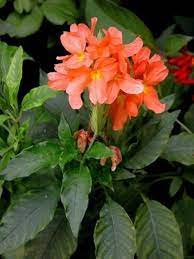
Effective Disease Management in Crossandra
Share
INTRODUCTION
Crossandra (Crossandra infundibuliformis), commonly known as the Firecracker Flower or Crossandra, is a beautiful flowering plant that is cherished for its vibrant blooms and lush foliage. However, like any plant, Crossandra is susceptible to various diseases that can affect its health and appearance. In this blog post, we will explore some common diseases that affect Crossandra and discuss effective management strategies to keep your plants healthy and thriving.

Common Diseases of Crossandra
Powdery Mildew:
This fungal disease appears as white powdery patches on the leaves and stems of Crossandra. It thrives in humid conditions and can weaken the plant over time if left untreated.
Leaf Spot:
Leaf spot diseases cause dark, water-soaked spots on the leaves of Crossandra. These spots may eventually enlarge and cause the leaves to yellow and drop prematurely.
Root Rot:
Root rot is often caused by overwatering or poorly drained soil. It results in the roots becoming mushy and discolored, leading to wilting and overall decline of the plant.
Integrated Disease Management (IDM) Strategies
Cultural Practices
Watering: Ensure proper watering practices by allowing the soil to dry slightly between waterings. Avoid overhead watering to reduce humidity around the plant, which can contribute to fungal diseases like powdery mildew.
Air Circulation: Promote good air circulation around Crossandra plants by spacing them adequately and avoiding overcrowding. This helps reduce humidity and minimize the risk of fungal infections.
Sanitation: Remove and destroy any infected plant debris promptly. This prevents the spread of diseases and reduces the likelihood of reinfection.
Fungicides and Treatments
Fungicidal Sprays: Apply fungicidal sprays at the first sign of fungal infections like powdery mildew or leaf spot.
Follow the manufacturer's instructions carefully when applying these treatments.

Soil Management
Well-Drained Soil: Ensure Crossandra is planted in welldrained soil to prevent waterlogging and reduce the risk of root rot. Incorporate organic matter into the soil to improve its structure and drainage

Monitoring and Early Detection
Regularly inspect Crossandra plants for any signs of disease or pest infestations. Early detection allows for prompt intervention and better disease management outcomes.
Conclusion
Each plant species may have specific disease susceptibilities, so always research and tailor your management practices accordingly. With care and attention, you can enjoy the beauty of Crossandra in your garden for years to come.
